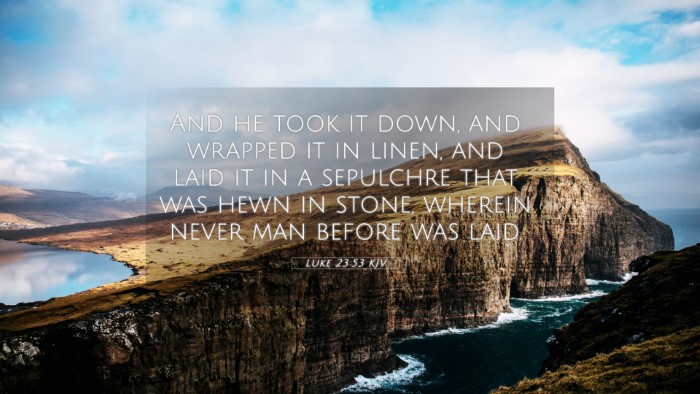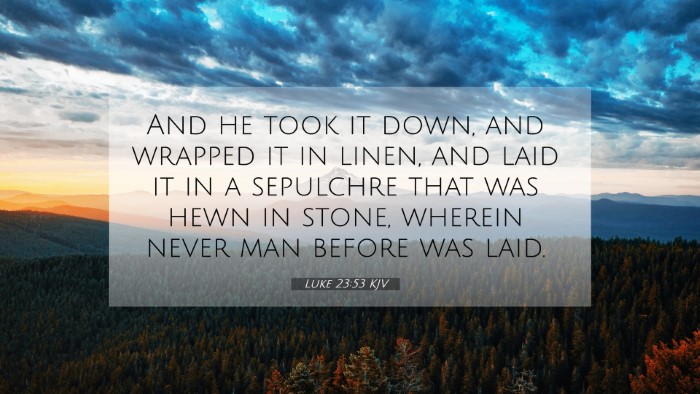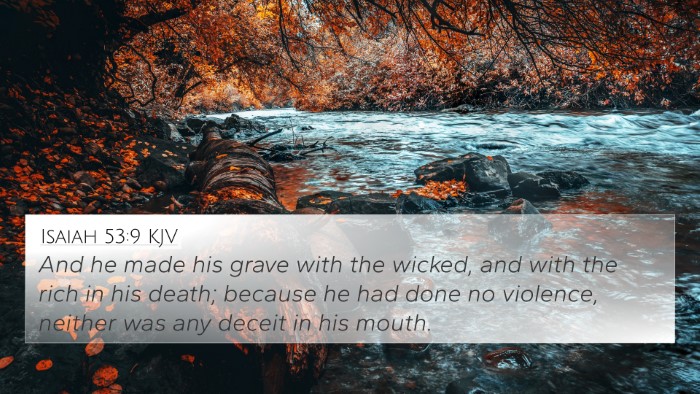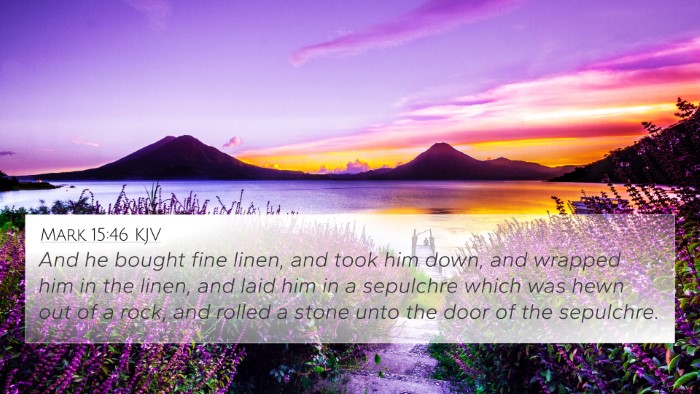Understanding Luke 23:53
Luke 23:53 states: "And he took it down, and wrapped it in linen, and laid it in a sepulchre that was hewn in stone, wherein never man before was laid." This verse tells of the burial of Jesus after His crucifixion. To comprehend the depth of this moment, we will explore insights from various public domain commentaries, including those by Matthew Henry, Albert Barnes, and Adam Clarke.
Context and Significance
This verse captures a pivotal event in the Passion narrative, marking the transition from Jesus' death to the resurrection. Notably, this act of burial is crucial to fulfilling the prophecies about the Messiah, a significant theme in Biblical literature. The placement of Jesus in a new, unused tomb symbolizes His unique role and the new covenant He establishes.
Matthew Henry’s Commentary
Matthew Henry remarks on the carefulness and respect shown by Joseph of Arimathea, who was a secret disciple of Jesus. He highlights how this act of burial indicates the end of Jesus' earthly ministry and foreshadows His resurrection. Henry notes the importance of the tomb being unoccupied, which signifies that Jesus does not belong to mortality.
Albert Barnes’s Perspective
Albert Barnes emphasizes the significance of Joseph’s actions and the implications of Jesus being laid in a sepulchre hewn in stone. He views this as a testament to authentic discipleship, filled with honor, as well as a fulfillment of prophecies regarding the Messiah’s burial. Barnes also connects this scene with Isaiah 53:9, where it is prophesied that the Messiah would be buried with the rich.
Adam Clarke’s Insights
Adam Clarke provides a theological perspective on the event, suggesting that the act of burial serves to confirm Jesus' death in the eyes of the witnesses and detractors. He notes that the tomb symbolizes hope, as it is the vessel through which resurrection will occur. Clarke draws parallels with Psalm 16:10 regarding the assurance of God's presence and resurrection.
Thematic Connections and Cross-References
This verse is interconnected with several other Scripture passages that elucidate its meaning in the context of the overall Biblical narrative.
- Isaiah 53:9 - Prophecy concerning the burial of the suffering servant.
- Matthew 27:57-61 - A parallel account of Joseph’s role in Jesus' burial.
- John 19:41-42 - Emphasizing the tomb's newness and its prophetic significance.
- Mark 15:40-47 - Identifying the individuals who witnessed the burial.
- Psalm 16:10 - Affirmation of God's promise not to abandon the Holy One to decay.
- Acts 2:31 - Peter’s sermon referencing Jesus’ resurrection in relation to His burial.
- Romans 6:4 - Understanding baptism in the light of Jesus’ death and burial.
- 1 Corinthians 15:4 - The Gospel's proclamation that Christ was buried and raised on the third day.
Interpretive Themes and Symbolism
The act of burial encapsulated within Luke 23:53 represents themes of sacrifice, redemption, and the promise of resurrection. The usage of a richly ordained tomb denotes the honor of Jesus, contrasting the dishonor typically associated with crucifixion. This thematic exploration draws a bridge between Old Testament prophecies and their fulfillment in the New Testament, providing a cohesive understanding of Biblical narrative through cross-referencing.
Conclusion
In reflecting upon Luke 23:53, we observe the pivotal nature of Jesus' death and burial. The connections made through cross-references enrich our understanding and reveal the profound implications of this moment in salvation history. As scholars, educators, and believers, engaging with these nuances through a comprehensive Bible cross-reference guide enhances our perception of Scripture.
Cross-Referencing for Deeper Insights
Enriching one’s Bible study through tools like a Bible concordance or a cross-reference Bible study guide can significantly enhance the understanding of connections between Bible verses. The use of a Bible cross-reference system can help identify links across the scriptures, allowing for a detailed comparative analysis.
Tools for Finding Cross-References
- Utilizing a bible concordance to explore thematic connections.
- Employing a bible reference resource for extensive cross-referencing.
- Participating in cross-reference Bible study methods for deeper understanding.
- Using bible chain references for studying related verses.
Encouragement to Explore
As you delve deeper into the connections between Bible verses, consider how the experiences of Jesus encapsulated in Luke 23:53 relate to themes of hope, resurrection, and the overarching narrative of redemption throughout Scripture. Bible verses that relate to each other form a rich tapestry of faith, illustrating God's continuous dialogue with humanity.
Final Thoughts
This verse is not merely about an event; it is a cornerstone that helps illuminate the grand narrative of the Bible. Understanding its significance allows believers to appreciate the connectedness throughout the scriptures, urging individuals to continue seeking deeper meanings within their faith journeys.





